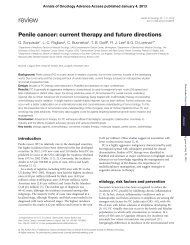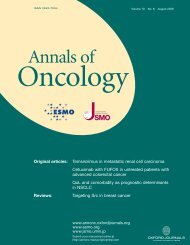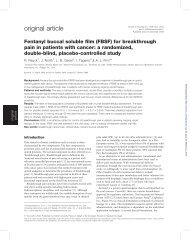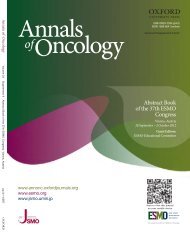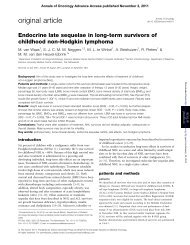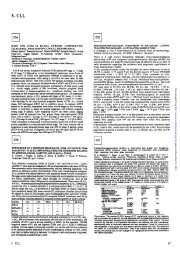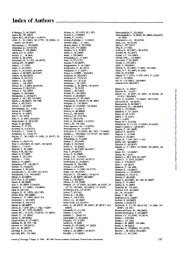letter to the editor - Annals of Oncology
letter to the editor - Annals of Oncology
letter to the editor - Annals of Oncology
You also want an ePaper? Increase the reach of your titles
YUMPU automatically turns print PDFs into web optimized ePapers that Google loves.
<strong>letter</strong> <strong>to</strong> <strong>the</strong> edi<strong>to</strong>r<br />
Reply <strong>to</strong> ‘Conclusions regarding<br />
relative cost–utility <strong>of</strong> alternative<br />
strategies for use <strong>of</strong> aromatase<br />
inhibi<strong>to</strong>rs in postmenopausal<br />
women with early breast cancer<br />
are premature’ by Delea et al.<br />
The <strong>letter</strong> by Delea et al. [1] raises several interesting questions<br />
with respect <strong>to</strong> cost–utility assessment. In principle, such<br />
analyses may be conducted in two different ways: we may<br />
calculate utilities based on actual data from <strong>the</strong> literature, which<br />
is <strong>the</strong> most common practice, or we may do what I did [2], i.e.<br />
assume a certain long-term effect and see whe<strong>the</strong>r that should<br />
provide a reasonable cost–utility estimate. For reasons <strong>to</strong> be<br />
explained below, I believe <strong>the</strong> second option is <strong>of</strong> particular<br />
value when assessing use <strong>of</strong> aromatase inhibi<strong>to</strong>rs at this stage.<br />
In <strong>the</strong> first part <strong>of</strong> <strong>the</strong>ir <strong>letter</strong>, Delea et al. discuss <strong>the</strong> relapse<br />
rates detected in <strong>the</strong> different phase III studies. This is an<br />
interesting <strong>to</strong>pic indeed; never<strong>the</strong>less, it is difficult <strong>to</strong> see <strong>the</strong><br />
relevance <strong>to</strong> <strong>the</strong> discussion <strong>of</strong> <strong>the</strong> model applied in this study.<br />
Here, <strong>the</strong> assumption was that each approach (an aromatase<br />
inhibi<strong>to</strong>r upfront or following 2–3 or 5 years on tamoxifen)<br />
would cause a 2% absolute improvement in long-term relapsefree<br />
survival and, if so, what would be <strong>the</strong> difference with<br />
respect <strong>to</strong> cost–utility? The reason for using such an approach is<br />
<strong>the</strong> uncertainty regarding long-term effects with aromatase<br />
inhibi<strong>to</strong>rs. Nei<strong>the</strong>r <strong>the</strong> data from <strong>the</strong> MA17 or any <strong>of</strong> <strong>the</strong> o<strong>the</strong>r<br />
phase III trials allow us <strong>to</strong> estimate long-term effects with<br />
respect <strong>to</strong> efficacy or <strong>to</strong>xicity. A few examples may illustrate<br />
this. Based on safety data, <strong>the</strong> argument has been raised that<br />
<strong>the</strong>re could be a difference in cardiovascular morbidity between<br />
anastrozole and letrozole. If so, it may be related <strong>to</strong> a more<br />
potent aromatase inhibition <strong>of</strong> letrozole compared with<br />
anastrozole [3]. In case this has an impact on <strong>the</strong> side-effect<br />
pr<strong>of</strong>ile, we could assume a difference with respect <strong>to</strong> antitumor<br />
efficacy as well. Similarly, <strong>the</strong> minor androgen-agonistic activity<br />
<strong>of</strong> exemestane [4] may impact not only on bone density, but<br />
could explain <strong>the</strong> lack <strong>of</strong> complete cross-resistance between <strong>the</strong><br />
individual aromatase inhibi<strong>to</strong>rs [5], enhancing antitumor<br />
efficacy.<br />
Thus, we are left with a number <strong>of</strong> open questions regarding<br />
potential differences between individual drugs, regimen <strong>of</strong><br />
application (mono<strong>the</strong>rapy versus sequential) as well as longterm<br />
effects. Using a model as applied—comparing cost–utility<br />
between different approaches based on assumption <strong>of</strong> similar<br />
efficacy as well as side-effects between compounds—may allow<br />
ª 2006 European Society for Medical <strong>Oncology</strong><br />
<strong>Annals</strong> <strong>of</strong> <strong>Oncology</strong> Advance Access published July 27, 2006<br />
<strong>Annals</strong> <strong>of</strong> <strong>Oncology</strong><br />
<strong>the</strong> reader <strong>to</strong> compare follow-up results <strong>to</strong> <strong>the</strong> assumptions<br />
included in <strong>the</strong> model. It is difficult <strong>to</strong> see why <strong>the</strong> details<br />
provided by Delea et al. with respect <strong>to</strong> short-time results<br />
should refute this approach. On <strong>the</strong> contrary, <strong>the</strong> fact that<br />
annual risk <strong>of</strong> breast cancer relapse is a non-linear process<br />
invalidates any form <strong>of</strong> indirect comparison <strong>of</strong> benefits between<br />
trials as indicated by Delea et al.<br />
Next, <strong>the</strong>y criticize <strong>the</strong> study for not including a potential<br />
impact on contralateral breast cancer and costs <strong>of</strong> recurrence.<br />
With due respect, <strong>the</strong>se data are provided in Table 4 and<br />
Figure 4, respectively [2]. The reason for not including <strong>the</strong>m<br />
in <strong>the</strong> initial analysis is <strong>the</strong> uncertainties with respect <strong>to</strong> <strong>the</strong>se<br />
parameters. While preliminary results from <strong>the</strong> phase III studies<br />
indicate a dramatic reduction in contralateral breast cancer, we<br />
lack information as <strong>to</strong> whe<strong>the</strong>r this could be a short- or longterm<br />
effect. Considering costs <strong>of</strong> treatment <strong>of</strong> relapse, this<br />
scenario is rapidly changing due <strong>to</strong> implementation <strong>of</strong> novel,<br />
expensive targeted <strong>the</strong>rapies as well as cy<strong>to</strong><strong>to</strong>xic compounds.<br />
Also, <strong>the</strong>re are reasons <strong>to</strong> believe that <strong>the</strong>se costs may vary<br />
considerably between different countries. Accordingly, <strong>the</strong><br />
result <strong>of</strong> this analysis is presented as a separate diagram. As<br />
pointed out by Delea et al., tamoxifen has a beneficial effect on<br />
BMD in postmenopausal women [6], although its effect with<br />
respect <strong>to</strong> preventing fractures is more difficult <strong>to</strong> estimate.<br />
Fur<strong>the</strong>rmore, it is not obvious that treating patients with<br />
tamoxifen for 5 years before implementing an aromatase<br />
inhibi<strong>to</strong>r may prevent potential detrimental effects on bone<br />
metabolism. Considering data from <strong>the</strong> MA 17 [7], <strong>the</strong><br />
difference in annual bone loss between <strong>the</strong> letrozole arm and<br />
<strong>the</strong> placebo arm was greater than that recorded in <strong>the</strong> 027<br />
pro<strong>to</strong>col comparing exemestane with placebo in tamoxifennaive<br />
patients [8, 9]. Assessing <strong>the</strong> impact <strong>of</strong> an increased<br />
fracture risk on cost–utility, similar <strong>to</strong> that for survival, <strong>the</strong>se<br />
are <strong>the</strong>oretical assumptions, illustrating different scenarios.<br />
Again, by providing <strong>the</strong>se estimates, it allows future readers <strong>to</strong><br />
assess cost–utility based on follow-up results.<br />
Considering potential effects <strong>of</strong> tamoxifen on cardiovascular<br />
events and death, this is a complex issue. Looking at <strong>the</strong> most<br />
recent Oxford meta-analysis [10], <strong>the</strong> number <strong>of</strong> trials by which<br />
<strong>the</strong> exact cause <strong>of</strong> CV mortality was reported is low with<br />
a limited number <strong>of</strong> observations. Looking at <strong>the</strong> risk <strong>of</strong> CV<br />
death, <strong>the</strong>re seems <strong>to</strong> be a small benefit in favor <strong>of</strong> tamoxifen in<br />
comparison <strong>to</strong> placebo, although <strong>the</strong> statistical significance is<br />
border-line. While recent evidence suggests potential benefits<br />
may appear several years after terminating tamoxifen [11],<br />
hence fur<strong>the</strong>r complicating this issue, evidence from <strong>the</strong> WHI<br />
study [12] indirectly suggests hormonal manipulation may<br />
have minor effects on CV death. I concur with <strong>the</strong> statement by<br />
Delea et al. that we need more information, in particular with<br />
Downloaded from<br />
http://annonc.oxfordjournals.org/ by guest on July 19, 2013<br />
<strong>letter</strong> <strong>to</strong><br />
<strong>the</strong> edi<strong>to</strong>r
<strong>letter</strong> <strong>to</strong> <strong>the</strong> edi<strong>to</strong>r<br />
respect <strong>to</strong> long-term data <strong>to</strong> learn all <strong>the</strong> details with respect <strong>to</strong><br />
effectiveness. I do not, however, concur with <strong>the</strong>ir negative and<br />
unsubstantiated statement claiming this analysis fails with<br />
respect <strong>to</strong> assumptions and interpretation <strong>of</strong> results.<br />
E. Lonning*<br />
Institute <strong>of</strong> Medicine Haukeland University Hospital, Department <strong>of</strong><br />
<strong>Oncology</strong>, Bergen, Norway<br />
(*E-mail: per.lonning@helse-bergen.no)<br />
references<br />
1. Delea TE, Karnon J, Goss PE. Conclusions regarding relative cost-utility <strong>of</strong><br />
alternative strategies for use <strong>of</strong> aromatase inhibi<strong>to</strong>rs in postmenopausal women with<br />
early breast cancer are premature. Ann Oncol; doi:10.1093/annonc/mdl171.<br />
2. Lønning PE. Comparing cost/utility <strong>of</strong> giving an aromatase inhibi<strong>to</strong>r as<br />
mono<strong>the</strong>rapy for 5 years versus sequential administration following 2–3 or 5<br />
years <strong>of</strong> tamoxifen as adjuvant treatment for postmenopausal breast cancer. Ann<br />
Oncol 2006; 17: 217–225.<br />
3. Geisler J, Haynes B, Anker G, Dowsett M, Lønning PE. Influence <strong>of</strong> letrozole<br />
(Femara) and anastrozole (Arimidex) on <strong>to</strong>tal body aromatization and plasma<br />
estrogen levels in postmenopausal breast cancer patients evaluated in<br />
a randomized, cross-over-designed study. J Clin Oncol 2002; 20: 751–757.<br />
4. Johannessen DC, Engan T, Salle ED et al. Endocrine and clinical effects <strong>of</strong><br />
exemestane (PNU 155971), a novel steroidal aromatase inhibi<strong>to</strong>r, in<br />
postmenopausal breast cancer patients: a phase I study. Clin Cancer Res 1997;<br />
3: 1101–1108.<br />
2 | <strong>letter</strong> <strong>to</strong> <strong>the</strong> edi<strong>to</strong>r<br />
5. Lønning PE, Bajetta E, Murray R et al. Activity <strong>of</strong> exemestane in metastatic breast<br />
cancer after failure <strong>of</strong> nonsteroidal aromatase inhibi<strong>to</strong>rs: a phase II trial. J Clin<br />
Oncol 2000; 18: 2234–2244.<br />
6. Powles TJ, Hickish T, Kanis JA, Tidy A, Ashley S. Effect <strong>of</strong> tamoxifen on<br />
bone mineral density measured by dual-energy X-ray absorptiometry in<br />
healthy premenopausal and postmenopausal women. J Clin Oncol 1996;<br />
14: 78–84.<br />
7. Perez EA, Josse RG, Pritchard KI et al. Effect <strong>of</strong> letrozole versus placebo on<br />
bone mineral density in women completing >5 years (yrs) <strong>of</strong> adjuvant<br />
tamoxifen: ncic ctg ma.17b. Breast Cancer Res Treat 2004; 88 (Suppl 1):<br />
Abstr 404, s36.<br />
8. Lønning PE, Geisler J, Krag LE et al. Effects <strong>of</strong> exemestane administered for 2<br />
years versus placebo on bone mineral density, bone biomarkers, and plasma<br />
lipids in patients with surgically resected early breast cancer. J Clin Oncol 2005;<br />
23: 5126–5137.<br />
9. Geisler J, Lønning PE. Aromatase inhibi<strong>to</strong>rs as adjuvant treatment <strong>of</strong> breast<br />
cancer. Crit Rev Oncol Hema<strong>to</strong>l 2006; 57: 53–61.<br />
10. Group EBCTC. Effects <strong>of</strong> chemo<strong>the</strong>rapy and hormonal <strong>the</strong>rapy for early breast<br />
cancer on recurrence and 15-year survival: an overview <strong>of</strong> <strong>the</strong> randomised trials.<br />
Lancet 2005; 365: 1687–1717.<br />
11. Nordenskjold B, Rosell J, Rutqvist LE et al. Coronary heart disease mortality after<br />
5 years <strong>of</strong> adjuvant tamoxifen <strong>the</strong>rapy: Results from a randomized trial. Journal <strong>of</strong><br />
<strong>the</strong> National Cancer Institute 2005; 97: 1609–1610.<br />
12. Anderson GL, Limacher M, Assaf AR et al. Effects <strong>of</strong> conjugated, equine<br />
estrogen in postmenopausal women with hysterec<strong>to</strong>my. The women’s<br />
health initiative randomized controlled trial. JAMA 2004; 291:<br />
1701–1712.<br />
doi:10.1093/annonc/mdl170<br />
<strong>Annals</strong> <strong>of</strong> <strong>Oncology</strong><br />
Downloaded from<br />
http://annonc.oxfordjournals.org/ by guest on July 19, 2013



